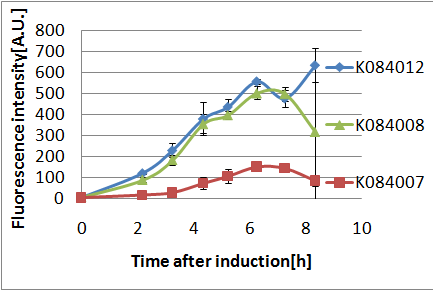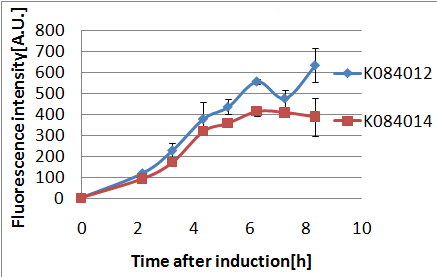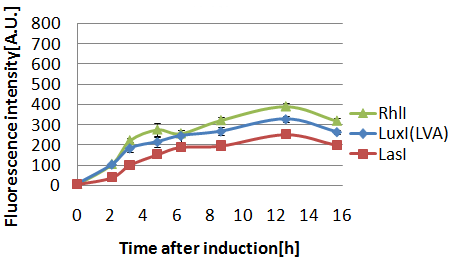Team:Chiba/Sender experiments/Senders(XL10Gold) T9002(JW1908)
From 2008.igem.org
| Home | The Team | The Project | Parts Submitted to the Registry | Reference | Notebook | Acknowledgements |
|---|
Results
Reaction temparature:37°C
- Sender culture:500μL,Receiver:500μL
- result
Cultures containing cells transformed with LuxI gene([http://partsregistry.org/Part:BBa_K084012 BBa_K084012])and cells transformed with RhlI gene([http://partsregistry.org/Part:BBa_K084008 BBa_K084008]) express gfp and fluorescence intensity was reached to 500.Cultures containing cells transformed with LasI gene([http://partsregistry.org/Part:BBa_K084007 BBa_K084007]) weakly expressed gfp,and fluorescence intensity was not reached to a significant level.
- Discussion:Maximum fluorescence intensity was vary,however,time before gfp expression doesn't differ.
- We concluded that LasI gene([http://partsregistry.org/Part:BBa_K084007 BBa_K084007]) was not work well at this condition.
middle
- Results
Fluorescence intensity of the culture containing cells transformed with LuxI gene([http://partsregistry.org/Part:BBa_K084012 BBa_K084012]) was lower than that of the cultures containing the cells transformed with LVA LuxI-LVA gene([http://partsregistry.org/Part:BBa_K084014 BBa_K084014]).The difference of maximum fluorescence intesity between the two cultures was 200.
- Discussion
- The rate of AHL synthesis decreased by the degradation of autoinducer synthase,however,the length of time before gfp expression is same.
- right
- Result
Cultures containing cells transformed with RhlI gene([http://partsregistry.org/Part:BBa_K084008 BBa_K084008]) and RhlI+LVA([http://partsregistry.org/Part:BBa_K084009 BBa_K084009]) draw the same transfer curve.
- Discussion
- We concluded that there was no effect of LVA-tag on time before gfp expression.
Reaction temparature:30°C
- Sender culture:500μL, Receiver culture:500μL
- 左
- 結果
- 蛍光強度はRhl,LuxI+LVA,LasIの順に高かった。
- LuxI,RhlIとLasIは蛍光強度200に達するまでの時間差は約2時間だった
- 考察
- 30°CではRhlIの活性のほうがLuxIより高い。もしくは、LVAの効果が出ている。その場合、右のグラフ
- 結果
のLVA自体に問題があると考えられる。
- 右
- 結果
- RhlI+LVAとRhlIでは値はほぼ同じだった
- 考察
- LVAが働いていないか、働いていたとしてもこの条件だとAHLシンターゼの合成速度のほうが
- 結果
かなり大きいと考えられる
Reaction temparature:25°C
Sender culture:500μL,Receiver culture:500μL
- Left:
- result
- 30°C,37°Cの実験時に比べて蛍光強度が極端に低く,ネガコンと差がほとんどなかった.
- LuxI,RhlIに比べてLasIにおける最終形高強度は約1/2と低いものであった。
- Discussion
- 蛍光強度が極端に下がったのは30°C,37°Cで行った実験と比べ温度が低いため活性が落ちたためと考えられる。
- またそれだけではなく静置して行ったためSenderとReceiverがよく混ざらず、その結果GFPの発現量が大幅に減少した可能性も考えられる。
- result
- Right:
- Result
- RhlIにLVAtagのついているものは,LVAtagのついていないものに比べて最大蛍光強度が小さかった.
- Discussion
- LVAtag is effective in this condition.
- Result
|Back to Sender experiment and result
 "
"









